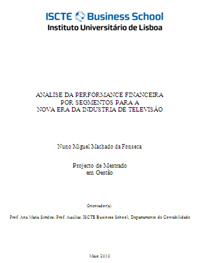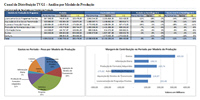 | ||||||||||||||
| ||||||||||||||
|
|
2 - Theoretical and Conceptual Framework This chapter aims to introduce generic major theoretical and conceptual relevance to achieving the objective of this work in order to select the best solutions to adopt the model to propose. Intended to introduce the control of management, his area of responsibility and instruments, the main models of organization and characteristics of financial information for management control and financial performance indicators considered most relevant for the purpose of finding the most appropriate assessing the financial performance by segment. 2.1 - Management Control 2.1.1 - Management Control Scope, characteristics and objectives The management control framework is the implementation of the strategic objectives of the organization. Since these targets of various kinds, not just financial (quality, productivity, innovation, image, etc.), instruments of management control shall accompany such diversity in nature of the targets (Jordan et al., 2007). Management control is one of the three functions of planning and control present in most companies, along with the strategic formulation and monitoring of tasks. Management control is between these two functions and is the process by which managers influence other members to implement the strategy of the organization. The system used by managers to monitor the activities in the organization is called the system management control (Anthony and Govindarajan, 2007). In business, the standard behavior is not predefined. Thus, part of the monitoring process is the comparison between the current situation and plans decided by the management. The management control thus involves planning and control, and these two components approximately the same importance. According to the three functions of planning and control previously described, the formulation has its strategic focus on long-term while the control task focuses on the short term. Although the two functions involve planning and control, planning is more important in strategy formulation and process control in the control task (Anthony and Govindarajan, 2007). Among the activities that involve the management control, we can highlight:
The planning is done in the circumstances at the time of its formulation. So if they are to change the actions outlined in the plan may no longer be the most appropriate. The management control does not necessarily require that all actions correspond to a particular plan, for example, a budget. Similarly, if you found a better approach in relation to previously determined to achieve the objectives of the organization, management control should not be a factor of obstruction (Anthony and Govindarajan, 2007). A management control system must be geared to action with a view to decision making in time, it should aim to produce documents for enriching the company or file for the mere construction of a statistical basis. The future should be the main orientation of management control, responding to information needs concerning the current situation of the company and also to forecast future results with a view to taking remedial decisions or change of plans, taking into account the alignment with business strategy (Jordan et al., 2007). 2.1.2 - Management Control Instruments Management control is used throughout the corporate hierarchy, however, not all have identical needs. If the Administration to have greater relevance to the degree of achievement of global objectives, to middle managers will have greater interest indicators relating to their area of business and operational managers to monitor the operation, considering the objectives and specific action plans (Simões , 2001). The instruments of management control must therefore respond to different needs. The various instruments were distributed by Jordan et al. (2007), in three categories: navigation tools; tools guiding the behavior and a means for dialogue. Among navigation tools we can fit those needed for management to set goals, plan, monitor results and take corrective action in order to better performances. They comprise: the operational plan (the operational definition of the strategy in the medium term, usually three years), budget (the setting of objectives in the short term, usually one year in conjunction with the operational plan), budget control, the tableaux bord and balanced scorecard. In contrast to the first instruments described, which are of a nature of estimates, budgetary control, the tableaux de bord and balanced scorecard are instruments of monitoring results. The latter two instruments have the main characteristics of rapid availability of information, diversity of indicators is not limited to financial indicators; synthesis and adaptation to the user. The instruments for guiding the behavior intended to regulate the actions and decisions of decentralized management, in order to meet the objectives of the organization rather than just responding to local targets and partial - possibly not aligned with the overall interests of the company. The instruments in this category are classifiable in the organization of responsibility centers, performance evaluation based on criteria tailored to the characteristics of responsibility centers and the implementation of transfer pricing (ITP's). The third category - the tools of dialogue - is to develop the internal dialogue involving all actors of the organizational pyramid. For top management, these instruments are an opportunity to spread the strategic project for the organization, allowing to inform the company's strategy, objectives and align with the corresponding activity of each area with the overall policy of the company. If the problem itself is complex, the instruments can be as simple as scheduling meetings or making their reports. |
|
||||||||||||
nunofonseca.com - All rights reserved.


